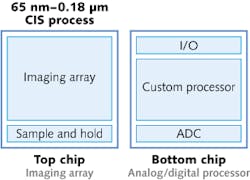As the number of devices connected to the Internet is expected to grow to more than 50 billion devices by 2020, this interconnected network of sensors—described as the Internet of Things (IoT)—has become the focus of a number of leading technology companies. Recognizing the growing demand for image capture and video streaming capability for these devices within a number of market applications (industrial, medical, automotive, and consumer), Forza Silicon (Pasadena, CA) has developed a reconfigurable image sensor technology platform to enable and accelerate new-product development within these markets; specifically, an initial application is for in-home fire detection.
The proof-of-concept 3D stacked-sensor platform uses a small-profile/low-power imaging array (0.18 μm CMOS image-sensor process) stacked on top of a low-power field-programmable gate array (FPGA) device from Lattice Semiconductor (Portland, OR) that is reconfigurable for different system interfaces, image-processing tasks, frame rates, power levels, and noise levels, for example. The sensor enables the ability to field-reconfigure the device for additional functions or firmware changes without the need for replacement of the physical product. It integrates image processing at the point of image capture (“edge”) to ensure quick and accurate decision-making by these smart devices. In the fire-sensing application, the chip is attached to a standard smoke detector and programmed to monitor ambient light level, awaken when the level changes due to a fire event, and send a livestream video notification of the event to the homeowner’s cell phone. Contact Annie Suede at [email protected].
